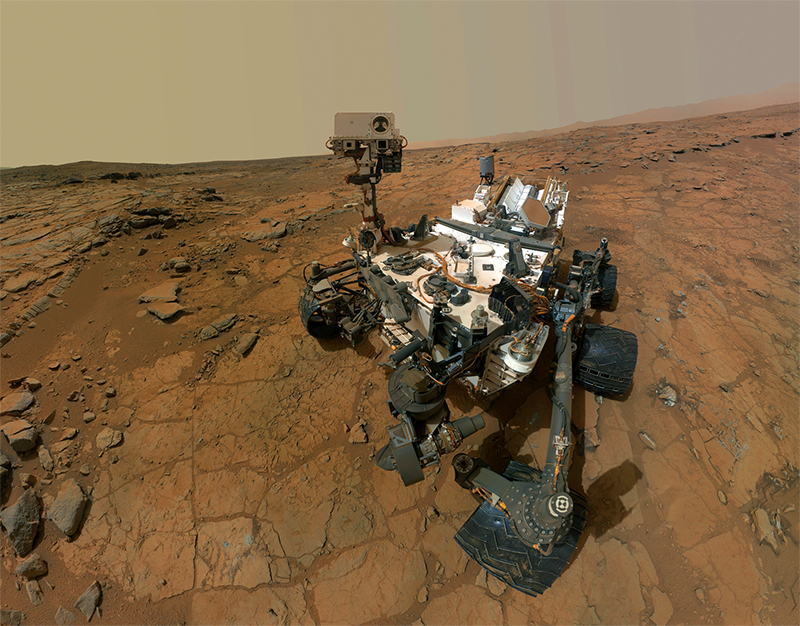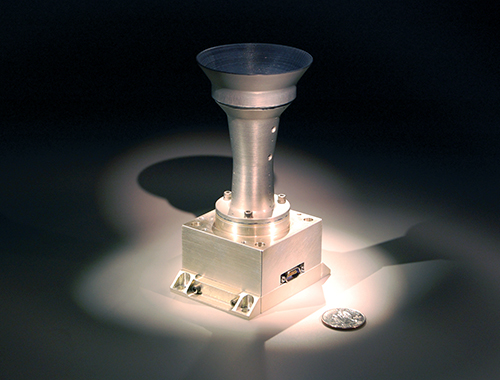
Cameras Monitor Spacecraft Integrity to Prevent Failures
NASA Technology
Is there—or was there ever—life on Mars? In August 2012 NASA’s Curiosity rover touched down on the surface of Mars in an attempt to answer what has become one of modern science’s most burning questions.
In preparation for such an endeavor, the rover had to be equipped with the latest technologies, one of which was a set of high quality, radiation-hardened cameras able to capture sharp, vibrant images of the Martian terrain time and time again. Scientists at the Mars Science Laboratory (MSL) mission use the cameras as their “eyes” to survey the landscape, guide the rover’s movement, and select rock and soil samples for further investigation.
To develop these critical components, the Jet Propulsion Laboratory entered into a contract with San Diego, California-based Malin Space Science Systems Inc. (MSSS), a small, privately owned company with big experience providing camera equipment for space missions.
Technology Transfer
Since its founding in 1990, MSSS has collaborated with NASA on a number of Agency missions, starting with developing and operating the ground data system of the Mars Observer Camera (MOC), which launched in 1992. When the MOC was rebuilt for use on the Mars Global Surveyor in 1996, the company oversaw the camera’s operations for the next decade. In the mid-1990s MSSS also began developing smaller, more modular camera systems for other spacecraft such as the Mars Climate Orbiter and the Mars Polar Lander.
When NASA put the call out for a firm to develop Curiosity’s cameras in 2004, the company once again stepped up and set about developing imagers that were both compact and cutting edge, mainly by implementing the latest technology used on consumer digital cameras. For MSSS, that meant installing focusable lenses in some of the cameras. It also meant using sensors with Bayer Pattern Filters for applying color to the imagery: compared to traditional filter wheels, these filters require less work and take up less data volume to transmit back to Earth.
By the time Curiosity launched in November 2011, the company had successfully fulfilled its contract and had equipped the car-sized rover with four cameras that would help scientists retrieve clues that would shed some light on the Red Planet’s natural history.
The images retrieved have since become part of both NASA and national lore. The Mars Descent Imager (MARDI)—purposed with orienting the spacecraft during its early operations—recorded the now famous video of the rover’s nerve-racking landing inside Gale Crater. The two Mast Cameras (Mastcams for short), which are mounted on a mast extending from Curiosity’s deck and charged with capturing the expansive Martian terrain in varying focal lengths, have revealed the dry and mountainous majesty of its landscape. The Mars Handheld Lens Imager (MAHLI)—capable of zooming in on features thinner than the diameter of a human hair—has sent the internet abuzz with images that keep people guessing as to what they might be.
In short, the cameras are performing well. “The hardware is working great, and the internal software, the controls, and the camera are all working well,” says Jeff Simmonds, the MSL payload manager who oversaw the cameras’ development. “And they’re taking images that are helping the science team do their science.”
Leveraging the experience gained in designing Curiosity’s cameras, combined with years of developing cameras for other space missions, MSSS has commercialized an affordable, off-the-shelf imaging system called ECAM that is meant to help in another way: by monitoring spacecraft functionality. Comprised of four cameras and a Digital Video Recorder (DVR) that serves as a central processing unit, the system is designed for installation onto satellites in order to probe and troubleshoot any issues that may arise in orbit.
Benefits
According to Michael Ravine, MSSS’s advanced projects manager, there is a big potential benefit in having the ECAM system installed onboard a spacecraft. He says there were some missions where, during a malfunction, if engineers back on Earth had been able to view images of the satellite, they would have been able to diagnose and tackle the problem earlier, or at least understand better what went wrong.
“You want to see what your spacecraft is doing,” he says. “You want to monitor the deployments of your antennas and solar arrays to see that they are working properly. You also might want to see what is going on around your spacecraft.”
Noting the durable construction of the product, Ravine says that it is also lightweight and economical in size yet built to withstand the hazards associated with launch and long durations in orbit. The ECAM’s components are radiation tolerant and athermalized to provide consistent performance over a wide range of temperatures. While the system comes with a set of predesigned cameras of varying resolutions and focal lengths to choose from, they can also be customized.
So far one ECAM system has been sold, and the company is in talks with many interested parties in both government and the private sector. Ravine says that, with the ripening market for both commercial space exploration and commercial satellites, MSSS is confident that these cameras will do well on the market.
When a satellite’s building and launch costs can easily soar into the hundreds of millions—or even billions—of dollars, Ravine says the ECAM is worth the investment in added security. “Being able to see your spacecraft can possibly avert some pretty disastrous things from happening.”

The ECAM imaging system is an off-the-shelf, cost-effective method of monitoring a spacecraft’s performance from Earth. Cameras can also be custom-built to meet the needs of the customer.

A self portrait of NASA’s Mars rover Curiosity. The image combines dozens of exposures captured by the rover’s Mars Hand Lens Imager, which is attached to its robotic arm













